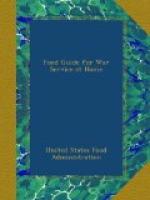The United States, more like England than Scotland, has used oats mostly for feed. The crop is second only to the corn-crop. Oats are eaten in the form of oatmeal, which is a finely granulated meal, and as the common rolled oats which have been steamed and put through rollers. There is little oat flour on the market at present. A successful and palatable home-made flour may be prepared by putting rolled oats through a food-chopper. Any of the forms of oats can be used in breads of all kinds, but the more finely ground flour can be substituted in larger proportion. The demand for oat products has grown so rapidly the last year that mills are running to their limit. Special machinery is required for its manufacture, so that a great increase in the supply is not feasible in a short time.
Barley and Rye. In using barley and rye for bread we are only going back to the methods of our forefathers. Barley is supposed to be one of the first cereals used by man. Good barley flour is a very acceptable substitute for wheat, but if too large a proportion of the kernel is included, it may be bitter in flavor.
Rye, of all the cereals, makes bread nearest like wheat, though the rye bread formerly made usually contained from 20 per cent to 80 per cent wheat flour. The supply is far below what we could well use. For this reason it is not included among the cereals which the housekeeper is allowed to buy on the 50-50 plan, and since March 31, 1918, bakers have not been allowed to use it as a substitute in baking on the same basis as the other substitutes.
Rice. Rice forms the chief food of hundreds of millions of people, and in many oriental countries is the staple cereal, like wheat with us. As a wheat substitute we may use it cooked whole or ground into a flour. The rice flour may be mixed with other cereals in making bread and cakes. The rice polish, which is a by-product secured by rubbing off with brushes the outside coating of the brown rice, is much cheaper. It has been sold chiefly for stock-feed, but it has possibilities as a flour substitute.
The rice-growers of the South are doing their best to supply the country with rice in quantity and to make known the possibilities of this cereal. The rice flour supply, though not large now, will doubtless be much increased by next year. One Louisiana mill, for example, is increasing its output from 150 to 1,200 barrels a day.
Other Cereal Substitutes. Besides the substitutes which are common all over the country, there are products produced in too small amounts to make them universal substitutes, such as buckwheat, cottonseed meal, and peanut flour, any of which can be used with other flours for baking. The Southwest produces both flour and meal from milo, kaffir, and feterita.
Flours are made from the Irish and sweet potato, from tapioca, from soy beans, and bananas, but they are manufactured in such small amounts that they do not take the place of wheat to any great extent. Potato flour comes nearest to doing this. It has always been used to some extent in Europe and it is being widely used in Germany now. Potato itself can be used instead of wheat. An extra potato at a meal will take the place of a large slice of bread.




